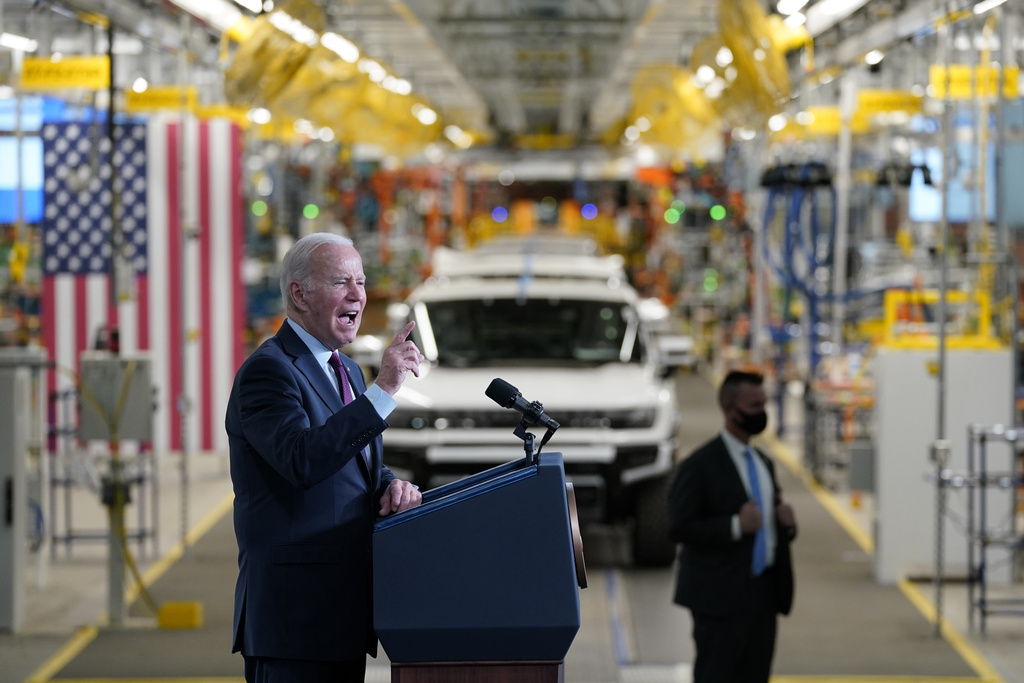Biden Administration EV Charger Claims Debunked Amid Debate \ Newslooks \ Washington DC \ Mary Sidiqi \ Evening Edition \ Social media claims that the Biden administration spent $7.5 billion on just eight electric vehicle (EV) chargers are false. The funds were allocated under the 2021 Infrastructure and Jobs Act to develop a nationwide EV charging network, with a goal of 500,000 chargers by 2030. To date, 214 chargers are operational, and thousands of projects are underway, managed at the state level.
Biden EV Charger Funding Controversy: Quick Looks
- The Misinformation: Social media falsely claims $7.5 billion was spent on only eight EV chargers.
- Funding Breakdown: The $7.5 billion allocation supports a nationwide network, not single projects.
- State-Led Effort: Individual states are responsible for building chargers, not the federal government.
- Current Progress: 214 chargers are operational, with nearly 25,000 projects underway.
- Funding Programs: $5 billion allocated via NEVI; $2.5 billion via CFI grants.
- Challenges: States face varying levels of infrastructure experience, delaying some projects.
- Broader Context: The program aims to create 500,000 chargers by 2030.
Deep Look
Unpacking the Claim
The social media claim asserts that the Biden administration squandered $7.5 billion constructing only eight chargers. However, this figure refers to the total funding allocated through the 2021 Infrastructure and Jobs Act—also known as the Bipartisan Infrastructure Law—for developing a nationwide EV charging network. The legislation aims to address climate goals and support EV adoption by creating 500,000 publicly accessible chargers by 2030.
Transportation Secretary Pete Buttigieg called the viral claim “false” in a series of posts on X (formerly Twitter). Buttigieg clarified that the federal government does not directly build chargers. Instead, it allocates funds to states, which are responsible for constructing and maintaining the charging stations. He further emphasized that only a fraction of the $7.5 billion has been spent, with the bulk of construction planned for the latter half of the decade.
How the $7.5 Billion is Allocated
The funding is divided into two major programs:
- National Electric Vehicle Infrastructure Formula Program (NEVI):
- Allocation: $5 billion, distributed annually from 2022 to 2026, with funds available through 2030.
- Purpose: Helps states build EV chargers that comply with federal standards.
- Special Focus: Ten percent of annual funds are reserved for states and localities requiring additional assistance.
- Charging and Fueling Infrastructure Discretionary Grant Program (CFI):
- Allocation: $2.5 billion, distributed through a competitive grant process.
- Purpose: Targets underserved and disadvantaged communities to ensure equitable access to EV charging and alternative fueling infrastructure.
Together, these programs aim to create a cohesive national network of charging stations, prioritizing accessibility and sustainability.
Progress Report
As of November 2024, the Federal Highway Administration (FHWA) has reported significant milestones:
- Operational Chargers: 214 chargers funded by the program are active across 12 states.
- Projects Underway: Nearly 24,800 chargers are in various stages of planning or construction.
- Public Chargers Nationwide: Over 203,000 chargers are currently available in the U.S., more than doubling the number from 2021.
Challenges in Implementation
Loren McDonald, an independent analyst tracking the EV charger rollout, highlighted that state governments bear the brunt of the responsibility for project execution. He noted that while some states have robust infrastructure and policies in place, others are starting from scratch. For example, Wisconsin had to pass new legislation to meet federal standards, delaying its rollout.
Misrepresentation by Critics
Despite the program’s intent and steady progress, critics have seized upon its challenges to paint it as a failure. Representative Michael Rulli, a Republican from Ohio, falsely claimed that the entire $7.5 billion had been spent to construct just eight chargers. In a post on X, Rulli described the initiative as “squandering billions on something nobody wants,” receiving over 62,900 likes and shares.
This narrative, while gaining traction online, fails to acknowledge the ongoing nature of the program, the state-led approach, and the extensive network under development.
Looking Ahead: Future Goals and Impacts
By the end of 2024, 37 states will have received their third round of NEVI funding, totaling $586 million. The FHWA has also announced $1.3 billion in awards through CFI and NEVI programs, with $779 million in grants still available. Importantly, these figures represent funds earmarked for projects, not amounts already spent.
The broader EV infrastructure effort includes contributions from federal tax incentives and private sector investments, which complement the funding provided by NEVI and CFI.
While the rollout is not without challenges, the initiative’s long-term vision positions the U.S. as a leader in sustainable transportation infrastructure. The coming years will determine whether the program achieves its ambitious targets and addresses the concerns raised by its critics.







